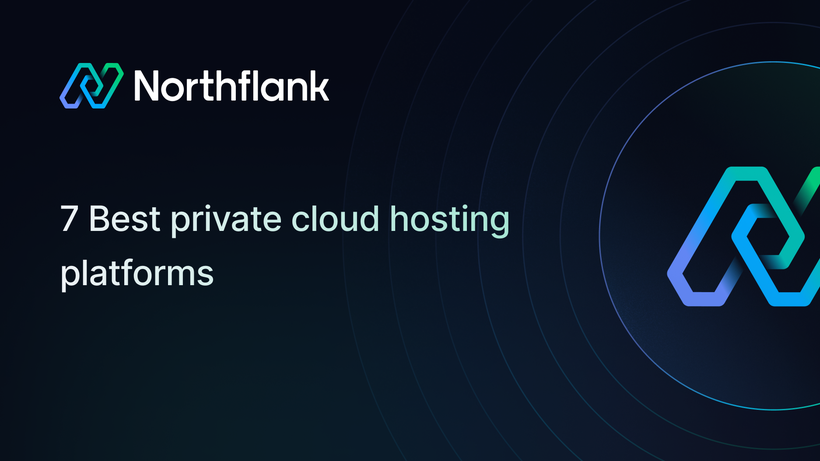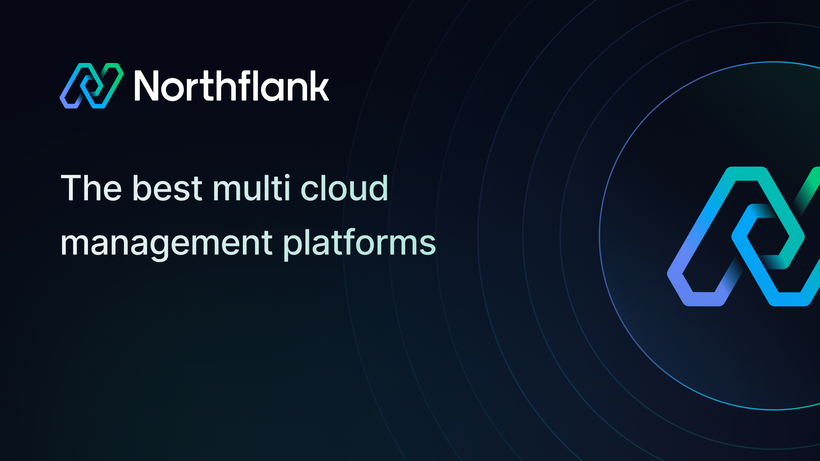

7 best Kapstan alternatives for Kubernetes deployment in 2025
💡 TL;DR: Northflank is the best Kapstan alternative for teams needing production-grade Kubernetes without YAML complexity. Railway ranks second for rapid prototyping, and Render takes third for simple web app deployments. Each platform solves specific pain points that Kapstan addressed.
Kapstan built its reputation on making Kubernetes deployments dead simple, no YAML wrestling, one-click environment cloning, and GitOps that actually works. With teams spending 20% of their time managing cloud infrastructure instead of building features, finding the right Kapstan alternative becomes critical for maintaining development velocity.
Engineering teams spend 20% of their time managing cloud infrastructure; time that should otherwise be spent on product development. The core problems Kapstan solved remain universal:
Kubernetes complexity: Writing YAML manifests, managing secrets, configuring ingress controllers, and debugging networking issues slow down feature delivery Environment management: Creating consistent dev/staging/prod environments without configuration drift DevOps bottlenecks: Removing dependency on specialized DevOps engineers for routine deployments Infrastructure ownership: Running in your own cloud account while maintaining platform convenience
| Feature | Northflank | Railway | Render | Porter | Fly.io | Vercel | Heroku |
|---|---|---|---|---|---|---|---|
| Multi-cloud | ✅ AWS/GCP/Azure | ❌ Railway only | ❌ Render only | ✅ Your clusters | ❌ Fly network | ❌ Vercel only | ❌ Heroku only |
| BYOC | ✅ Full support | ❌ No | ❌ No | ✅ Your K8s | ❌ No | ❌ No | ❌ No |
| Kubernetes access | ✅ Full API | ❌ Abstracted | ❌ Abstracted | ✅ Native | ❌ MicroVMs | ❌ Serverless | ❌ Dynos |
| Preview environments | ✅ Advanced | ✅ Branch-based | ✅ PR-based | ✅ Helm-based | ✅ App-based | ✅ Branch-based | ✅ Review apps |
| Enterprise auth | ✅ SAML/OIDC | ⚠️ Basic | ⚠️ Teams | ✅ K8s RBAC | ⚠️ Orgs | ✅ SAML/OIDC | ✅ SSO |
| Databases | ✅ Managed | ✅ One-click | ✅ Managed | ⚠️ Via K8 | ⚠️ Limited | ⚠️ 3rd party | ✅ Add-ons |
| Global CDN | ✅ Built-in | ❌ No | ✅ Built-in | ⚠️ Via ingress | ✅ Native | ✅ Edge network | ⚠️ Via add-ons |

Northflank leverages Kubernetes as an operating system to give you the best of cloud native, without the overhead, exactly like Kapstan did, but with significantly more enterprise features and multi-cloud flexibility.
True multi-cloud Kubernetes: Connect your account with Northflank to create and manage Kubernetes clusters in your own cloud account, and gain complete control of your infrastructure, data storage, security, and auditing across GCP, AWS, Azure, and bare metal.
Zero-config deployments: With Northflank, I can make 100 commits and 100 deployments in a single day, it keeps up with my pace like nothing else, exactly the developer velocity Kapstan users expect.
Production-grade security: Environment variables are encrypted at rest and securely injected at runtime into your containers and builds with fine-grained RBAC and SAML/OIDC integration for enterprises.
GitOps CI/CD: Build and deploy every commit you make, or create rules for branches and pull requests with automatic TLS, custom domains, and real-time deployment tracking.
Preview environments: Spin up automatic environments per pull request for fast feedback with isolated databases and services - critical for modern development workflows.
- Better multi-cloud: Runs natively on any cloud vs Kapstan's more limited options
- Enterprise ready: Used by Sentry and other production-scale companies
- More control: Full Kubernetes API access when needed
- Transparent pricing: Running services, jobs, and addons are pro-rated by the second
Best for: Teams wanting Kapstan's simplicity with more power and enterprise features

Railway delivers the "just deploy it" experience that made Kapstan popular, with even less configuration required.
Zero-config magic: Railway automatically detects your framework (Node.js, Python, Go, Rust, PHP) and deploys without any setup files or configuration.
Instant databases: One-click PostgreSQL, MySQL, MongoDB, Redis with automatic connection strings injected as environment variables.
Branch deployments: Every git branch gets its own deployment URL with isolated database - perfect for feature testing.
Simple pricing: Predictable monthly costs based on resource usage, not complex per-second billing.
- No bring-your-own-cloud options
- Limited enterprise authentication
- Less control over underlying infrastructure
- No advanced deployment strategies (blue-green, canary)
Best for: Startups and small teams prioritizing speed over enterprise features

Render focuses on making web app deployment as simple as Heroku but with modern infrastructure and better performance.
Automatic everything: Static sites, web services, background workers, cron jobs, and databases deploy with minimal configuration.
Performance focus: Built-in global CDN, automatic HTTP/2, and SSD-backed databases with connection pooling.
Preview environments: Pull request deployments with full service replication including databases.
Transparent pricing: No surprise bills with clear per-service pricing and automatic scaling.
- Single cloud provider (no multi-cloud)
- Limited Kubernetes access
- Fewer enterprise security features
- No infrastructure-as-code templates
Best for: Web-focused teams who want Heroku-style simplicity with better performance

If you already have Kubernetes clusters, Porter adds the Kapstan-style developer experience on top.
Kubernetes native: Connects to your existing EKS, GKE, AKS, or self-managed clusters while providing a simple deployment interface.
Helm integration: Deploy applications using visual Helm chart configuration instead of writing YAML.
Full control: Access to all Kubernetes primitives when needed, unlike platforms that abstract everything away.
Cost efficiency: No platform markup - you pay only your cloud provider's infrastructure costs plus Porter's licensing.
- Requires existing Kubernetes expertise
- You manage cluster upgrades and maintenance
- More complex than all-in-one platforms
- Limited managed services (databases, queues)
Best for: Teams with Kubernetes experience who want better developer UX

Runs your containers on a global network of physical servers for ultra-low latency worldwide.
Global edge network: Deploy to 30+ regions with automatic request routing based on user location.
MicroVM isolation: Applications run in Firecracker microVMs for better security than containers.
Global state: Persistent volumes replicated across regions with automatic failover.
IPv6 native: Built-in support for modern networking with Anycast routing.
- Learning curve for distributed systems concepts
- Limited managed services
- No traditional databases (Postgres, MySQL)
- Platform-specific networking requires migration effort
Best for: Applications needing global distribution and edge computing

Vercel handles frontend and serverless functions while PlanetScale provides branching databases - covering most modern app architectures.
Database branching: PlanetScale's schema branching works like Git for database changes.
Edge functions: Vercel Edge Functions run globally with sub-100ms response times.
Framework integration: Deep Next.js, Nuxt, SvelteKit integration with automatic optimization.
Developer experience: Git-based workflows for both code and database schema changes.
- JavaScript/TypeScript focused
- No support for complex microservices
- Limited background job processing
- Serverless constraints on execution time
Best for: Full-stack JavaScript applications and JAMstack sites

Despite being older, Heroku's buildpack system and add-on ecosystem remain compelling for certain use cases.
Mature ecosystem: Hundreds of add-ons for databases, monitoring, logging, and third-party integrations.
Buildpack system: Automatic language detection and dependency installation across many frameworks.
Enterprise features: Heroku Enterprise provides compliance, SSO, and advanced networking.
Proven reliability: Decades of production experience with clear operational practices.
- Expensive at scale compared to alternatives
- Limited container customization
- No modern deployment strategies
- Slower innovation compared to newer platforms
Best for: Teams prioritizing stability and ecosystem maturity over cutting-edge features
Inventory current setup: Document all services, databases, environment variables, and custom configurations currently deployed through Kapstan.
Dependency mapping: Identify service-to-service communication patterns, shared databases, and external integrations.
Performance requirements: Note current resource allocations, scaling patterns, and performance SLAs.
For most teams (startups and enteprises) that want to move fast: Choose Northflank for comprehensive features and compliance requirements.
For Startups: Consider Railway for simplicity or Render for web-focused applications.
For Kubernetes teams: Porter provides the smoothest transition if you have K8s expertise.
Parallel deployment: Run applications on both Kapstan and your chosen alternative during transition.
Environment-by-environment: Migrate development first, then staging, finally production.
Service-by-service: Move independent services first, then tackle interconnected components.
Data migration: Plan database migration carefully with backup and rollback procedures.
- Starter: Free for hobby projects
- Pro: $20/month per developer with usage-based compute
- Enterprise: Custom pricing with SLA and support
- Hobby: $5/month with $5 usage credit
- Pro: $20/month per user with usage-based billing
- Team: Custom pricing for organizations
- Individual: Free tier with paid services
- Team: $19/month per user
- Organization: $29/month per user with advanced features
- Community: Free for personal use
- Standard: $50/month per cluster
- Enterprise: Custom pricing with support
Northflank provides the best balance of simplicity and power, similar to Kapstan's original value proposition.
Yes, using parallel deployment strategies:
- Deploy applications to your chosen alternative
- Set up database replication or backup/restore
- Use DNS switching to redirect traffic
- Monitor performance and rollback if needed
Northflank's BYOC options make this migration smoother by maintaining familiar infrastructure patterns.
Northflank and Porter support any containerized application, making them the most flexible. Railway and Render have excellent support for popular frameworks but may require additional configuration for custom setups.
Most alternatives cost less than Kapstan due to increased competition:
- Railway: Often cheaper for small applications
- Northflank: Competitive enterprise pricing with more features
- Render: Transparent pricing without surprises
- Porter: Lowest cost if you manage your own infrastructure
Northflank scales from startup to enterprise with comprehensive platform features. Railway works well for small to medium teams, while Porter scales with your Kubernetes expertise.
Yes, with varying approaches:
- Northflank: JSON templates and full API access
- Porter: Standard Kubernetes manifests and Helm
- Railway/Render: Platform-specific configuration files
- Fly.io: fly.toml configuration files
Northflank provides the most comprehensive observability with built-in logs, metrics, tracing, and alerting. Other platforms offer basic monitoring with options to integrate external tools.
Go with Northflank if you want the closest thing to Kapstan's power with better enterprise features and multi-cloud flexibility. It's the safe choice for teams of any size.
Pick Railway if you're a startup prioritizing rapid deployment over advanced features. Perfect for MVP development and early-stage products.
Choose Render for web applications where you want Heroku-style simplicity with modern performance and reasonable pricing.
Select Porter if you have Kubernetes expertise and want to maintain infrastructure control while improving developer experience.
The key is matching your team's technical requirements, budget constraints, and growth trajectory with each platform's strengths. Most teams will find Northflank offers the best combination of Kapstan's original benefits with expanded capabilities needed for production-scale applications.


